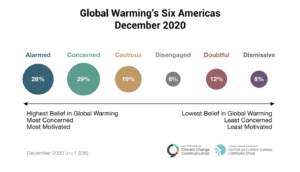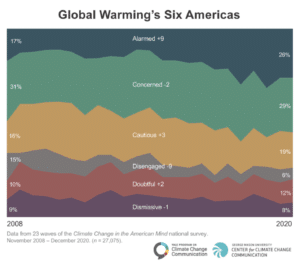New Year’s resolutions on climate action are too quaint for where we stand today: fighting an existential battle that is already well underway. The 2021 United Nations Report on Climate Change repeated the clarion call from its last report with even greater urgency: We are rapidly running out of time to limit global warming beyond 1.5 degrees Celsius over pre-industrial levels.
As 2022 kicks off, companies face challenges on many fronts: COVID has yet to loosen its grip, and supply chain constraints continue to vex many industries as record-breaking winter storms blanket parts of the U.S., including vital transportation routes. The climate crisis may seem like a distant threat when you’re facing such immediate concerns. But the truth is, your customers are experiencing a rising sense that climate change is here to stay, and they’re frustrated with the lack of a comprehensive, coherent response plan from both the public and private sector.
For purpose-driven companies, this is where a strong marketing campaign comes in — one that links the reality of climate change with equally real, actionable solutions such as rooftop solar energy, electric vehicles and other sustainable products.

Let’s start with the good news: Public support for climate solutions is growing.
American attitudes on climate have been changing, according to Climate Change in the American Mind (CCAM), a research study conducted twice yearly from 2008 through 2020 by the Yale Program for Climate Change Communication in association with George Mason University.
Americans who think global warming is happening outnumber those who do not by a factor of four to one.
Climate Change in the American Mind, March 2021
While geographic differences in opinion do exist, Americans are, by and large, waking up to the realities of climate change. A majority of Americans (64%) say they are at least “somewhat worried” about climate change. One in four Americans say they are “very worried.”
And perhaps most significantly, two out of three Americans (64%) now feel a personal sense of responsibility to help reduce global warming, according to researchers.
Now more than ever, Americans are ready to fight climate change with solutions that they can personally control.
Going Local: What Do Climate Attitudes Look Like Where You Live?
It’s all well and good to look at national public opinion, but when it comes to American consumer behavior, location matters. The Yale Public Opinion Maps provide details on the differences in public opinion down to each state, county and even Congressional district. (For a deeper dive on how American views and actions differ by sociodemographic and political factors, check out the CCAM Explorer tool.)
For those in the business of sustainable products and solutions, Yale’s Six Americas tool (first developed in 2008, evolved yearly since then) segments the American public into six audiences that each respond to the issue of climate change in their own unique ways:

Over the years, the proportion of the public that falls into the “Alarmed” category has increased – from 17% in 2008 to 26% today, while the number who are “Disengaged” has decreased. Clearly we are seeing the rise of a more climate-active public, as you can see from the graph below:

Moving from Climate Alarm to Adoption of Climate Solutions
At the heart of the climate action movement is the need to translate the rising concern over the climate crisis into actionable solutions.
Importantly, researchers point out that while the “Alarmed” category of respondents are convinced global warming is real and support strong climate policies, they do not have an equally strong understanding of what they or others can do to solve the problem.
This is why it’s so crucial to put forward a solutions-based message to the climate crisis.
For example, until now, solar marketing campaigns have focused primarily on the financial benefits of solar—and it’s been an effective strategy with a certain demographic. But the evolving attitudes of Americans toward climate suggest that a climate solution message could also play well. When 55% of the public is either “alarmed” or “concerned” about climate change, it begs the question: Are you presenting your message in the most compelling way to every sector of your audience?
One way to check is to use the Six Americas Super Short Survey as a barometer on where your audience stands on climate. With four simple questions you can segment your audience into actionable categories. You can even gamify the tool with landing pages that help you further segment your audience with key demographics.
All of this is to help you better understand your customers and prospects so that you can generate the content they’re interested in – and the solutions they are increasingly focused on adopting.
For more information on how to better segment your audience and make climate action a key part of your 2022 marketing strategy, reach out to us at Clean Power Marketing Group.
by Nancy Edwards, Managing Partner
Clean Power Marketing Group



